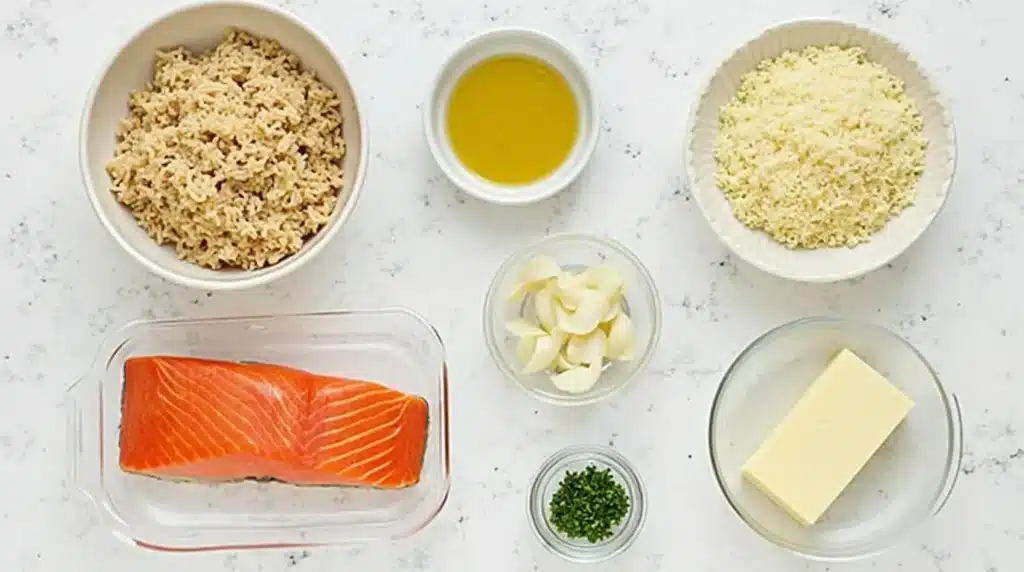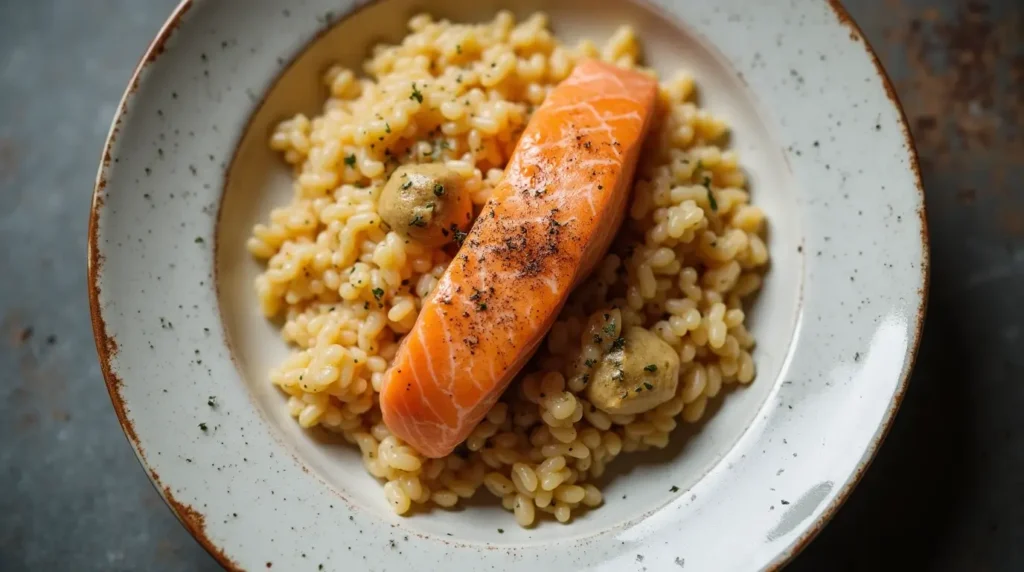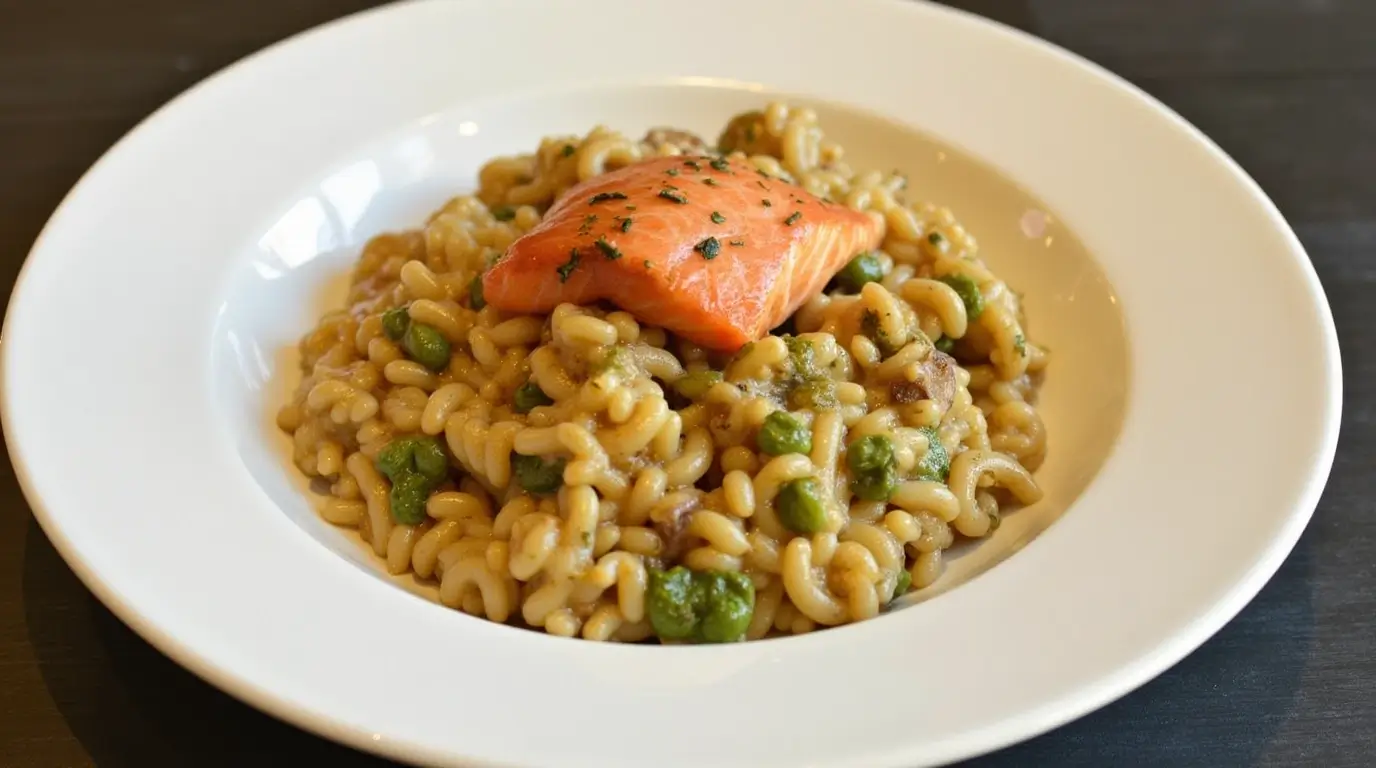Discover how to make luxurious and flavorful salmon risotto at home. This comprehensive guide includes recipes, tips, and variations.
Salmon risotto is a creamy, comforting dish. It combines the richness of risotto with the delicate flavor of salmon. This guide provides everything you need. Therefore, prepare to create a restaurant-quality meal.
Understanding Risotto: The Foundation of Your Dish
What is Risotto?
Risotto is an Italian rice dish. It’s cooked with broth to a creamy consistency. The constant stirring releases starch. Consequently, this creates the signature texture.
Arborio Rice: The Key to Creamy Risotto
Arborio rice is traditionally used. It’s a short-grain rice. It has a high starch content. This is essential for achieving creaminess. Therefore, it’s the best choice.
Other Rice Varieties for Risotto (Alternatives)
While Arborio is ideal, alternatives exist. Carnaroli rice is another good option. It produces a slightly firmer risotto. In a pinch, short-grain sushi rice can be used.
The Importance of Broth: Flavor Infusion
The broth infuses the rice with flavor. Use homemade fish broth or vegetable broth. For salmon risotto, fish broth enhances the seafood flavor. Therefore, consider making your own.
Toasting the Rice: Enhancing Nutty Flavor
Toasting the rice before adding liquid is crucial. This enhances its nutty flavor. It also helps the rice grains stay separate. Consequently, the risotto is not mushy.
PrintElevate Your Dinner: Mastering Creamy Salmon Risotto!
- Total Time: 35 minutes
- Yield: 4 servings 1x
Description
A rich and satisfying creamy salmon risotto featuring tender flakes of salmon, Arborio rice, and a touch of lemon for brightness. Comfort food with a gourmet twist.
Ingredients
1 tablespoon olive oil
1 small onion, finely chopped
2 garlic cloves, minced
1 cup Arborio rice
1/2 cup dry white wine (optional)
3 cups chicken or vegetable broth, warmed
1/2 cup heavy cream
1 tablespoon lemon juice
1 teaspoon lemon zest
1 cup cooked salmon, flaked
1/4 cup grated Parmesan cheese
Salt and pepper to taste
Fresh dill or parsley, for garnish
Instructions
1. In a large saucepan, heat olive oil over medium heat.
2. Add chopped onion and sauté until translucent, about 4–5 minutes.
3. Stir in garlic and cook for 1 more minute.
4. Add Arborio rice and toast for 1–2 minutes until slightly translucent around the edges.
5. Pour in white wine (if using) and stir until absorbed.
6. Begin adding warm broth, one ladle at a time, stirring frequently and allowing each addition to absorb before the next.
7. Continue until the rice is tender and creamy, about 18–20 minutes.
8. Stir in heavy cream, lemon juice, lemon zest, and flaked salmon.
9. Season with salt and pepper to taste, then stir in Parmesan cheese.
10. Remove from heat and let rest for 2 minutes.
11. Garnish with fresh herbs and serve immediately.
Notes
Use freshly cooked or leftover salmon—grilled, baked, or poached all work well.
For a dairy-free version, omit the cream and cheese and use a splash of coconut milk.
Risotto is best served immediately, but leftovers can be gently reheated with a splash of broth or cream.
- Prep Time: 10 minutes
- Cook Time: 25 minutes
- Category: Main Course
- Method: Stovetop
- Cuisine: Italian
Nutrition
- Serving Size: 1 bowl
- Calories: 460
- Sugar: 2g
- Sodium: 520mg
- Fat: 21g
- Saturated Fat: 9g
- Unsaturated Fat: 10g
- Trans Fat: 0g
- Carbohydrates: 45g
- Fiber: 2g
- Protein: 24g
- Cholesterol: 65mg
Keywords: salmon risotto, creamy risotto, seafood rice, lemon risotto
Selecting the Best Salmon for Your Salmon Risotto
Fresh vs. Frozen Salmon
Fresh salmon is ideal. However, high-quality frozen salmon works well. Thaw frozen salmon completely before using. Therefore, ensure it’s properly thawed.
Wild-Caught vs. Farm-Raised Salmon
Wild-caught salmon often has a richer flavor. It also tends to be leaner. Farm-raised salmon is more readily available. It can also be a sustainable choice. Therefore, consider your priorities.
Skin-On or Skinless Salmon?
For salmon risotto, skinless salmon is generally preferred. It’s easier to incorporate into the dish. However, you can cook the salmon with the skin on. Then, remove it before adding it to the risotto.
Preparing the Salmon: Cubing or Flaking
You can cube the salmon before cooking. Alternatively, cook it whole and flake it afterward. Cubing allows for even cooking. Flaking creates a more rustic texture.
Essential Ingredients for a Flavorful Salmon Risotto
Onions and Garlic: The Aromatic Base
Onions and garlic create the aromatic base. Finely chop them. This ensures they cook evenly. Yellow or white onions can be used.
White Wine: Adding Acidity and Depth
Dry white wine adds acidity and depth. It deglazes the pan. This releases flavorful bits. Use a wine you would enjoy drinking.
Parmesan Cheese: Creaminess and Umami
Parmesan cheese adds creaminess and umami. Use freshly grated Parmesan. This provides the best flavor. Therefore, avoid pre-grated cheese.
Butter: Richness and Shine
Butter adds richness and shine. Use unsalted butter. This allows you to control the salt content. Add it at the end for a glossy finish.
Fresh Herbs: Brightness and Aroma. Perfect for salmon risotto.
Fresh herbs add brightness and aroma. Parsley, dill, or chives pair well with salmon. Chop them finely. Add them at the end.
Optional Ingredients to Enhance Your Salmon Risotto

Lemon Zest and Juice: Adding Zing
Lemon zest and juice add a bright, citrusy flavor. This complements the salmon. Add it at the end. Therefore, it retains its freshness.
Vegetables: Adding Texture and Nutrients
Vegetables can be added for texture and nutrients. Asparagus, peas, or spinach are good choices. Add them towards the end of cooking.
Mushrooms: Adding Earthiness
Mushrooms add an earthy flavor. Sauté them separately. Then, add them to the risotto. Shiitake or cremini mushrooms work well.
Saffron: Adding Color and Luxury
Saffron adds a vibrant yellow color. It also has a unique flavor. Use it sparingly. It’s a luxurious addition.
Cream or Mascarpone: Extra Creaminess
For extra creaminess, add a touch of cream. Alternatively, use mascarpone cheese. Stir it in at the end. Therefore, the risotto is even richer.
Step-by-Step Guide: Making Perfect Salmon Risotto
Step 1: Preparing the Ingredients. Crucial for Salmon Risotto.
- Chop the onions and garlic.
- Grate the Parmesan cheese.
- Chop the fresh herbs.
- Prepare the salmon (cube or leave whole).
- Heat the broth.
Step 2: Toasting the Rice
Heat olive oil in a large pan or Dutch oven. Add the rice. Toast for 2-3 minutes, stirring constantly. The rice should become translucent.
Step 3: Sautéing the Onions and Garlic
Add the onions to the pan. Sauté until softened and translucent. Add the garlic. Cook for another minute.
Step 4: Deglazing with White Wine
Pour in the white wine. Stir and let it simmer. It should almost completely evaporate. This adds flavor to the rice.
Step 5: Adding the Broth Gradually
Add a ladleful of hot broth to the rice. Stir constantly. Wait until the liquid is almost completely absorbed. Then, add another ladleful.
Step 6: Continuing the Process for the Salmon Risotto.
Continue adding broth, one ladleful at a time. Stir constantly. This process takes about 20-25 minutes. The rice should be creamy but still al dente.
Step 7: Cooking the Salmon
While the risotto is cooking, prepare the salmon. If cubing, pan-fry or bake until cooked through. If cooking whole, pan-fry, bake, or poach.
Step 8: Adding the Salmon to the Risotto
Gently stir in the cooked salmon. Be careful not to break it up too much. If using flaked salmon, add it now.
Step 9: Stirring in the Cheese and Butter
Remove the risotto from the heat. Stir in the Parmesan cheese and butter. This adds creaminess and shine.
Step 10: Adding Herbs and Lemon (Optional)
Stir in the fresh herbs and lemon zest/juice (if using). This adds freshness and brightness. Therefore, don’t skip this step.
Step 11: Resting the Risotto
Let the risotto rest for a few minutes. This allows the flavors to meld. The consistency will also thicken slightly.
Step 12: Serving and Garnishing
Serve the salmon risotto immediately. Garnish with extra herbs or a drizzle of olive oil. Therefore, enjoy your creation.

Variations and Adaptations of Salmon Risotto
Smoked Salmon Risotto: A Different Flavor Profile
Use smoked salmon instead of fresh salmon. This adds a smoky flavor. Add it at the end. No need to cook it beforehand.
Lemon and Dill Salmon Risotto: A Classic Combination
Emphasize the lemon and dill flavors. Add extra lemon zest and juice. Use plenty of fresh dill. Therefore, you get a bright, refreshing dish.
Spicy Salmon Risotto: Adding Heat
Add a pinch of red pepper flakes. Alternatively, use a chili-infused olive oil. This adds a touch of heat. Therefore, adjust to your preference.
Vegetarian Risotto with Salmon: Pescatarian Option
Omit the chicken broth. Use vegetable broth instead. This makes the dish suitable for pescatarians. Therefore, it’s a versatile option.
Adding Other Seafood: Expanding the Flavors
Add other seafood to the risotto. Shrimp, scallops, or mussels pair well with salmon. Cook them separately. Then, add them to the risotto.
Troubleshooting Common Risotto Problems
Risotto Too Thick: Adding More Broth
If the risotto is too thick, add more hot broth. Add a little at a time. Stir until you reach the desired consistency.
Risotto Too Thin: Continuing to Cook
If the risotto is too thin, continue cooking. Stir constantly. The rice will continue to absorb liquid. It will eventually thicken.
Rice Undercooked: Extending Cooking Time
If the rice is still too firm, add more broth. Continue cooking. The rice should be al dente. It should have a slight bite.
Rice Overcooked: Avoiding Mushy Risotto
Overcooked risotto is mushy. Unfortunately, there’s no way to fix it. Be careful not to overcook the rice next time.
Risotto Lacking Flavor: Adjusting Seasoning
If the risotto lacks flavor, add more salt and pepper. You can also add more Parmesan cheese. A squeeze of lemon juice can also help.
Tips and Tricks for Perfect Salmon Risotto
Use Hot Broth: Maintaining the Temperature
Use hot broth throughout the cooking process. This ensures the rice cooks evenly. Cold broth will lower the temperature. This interrupts the cooking.
Stir Constantly: Releasing Starch for Creaminess
Constant stirring is essential. It releases the starch from the rice. This creates the creamy texture. Therefore, don’t skip this step.
Don’t Overcrowd the Pan: Ensuring Even Cooking
Use a large pan or Dutch oven. This allows the rice to cook evenly. Overcrowding the pan will lower the temperature.
Taste and Adjust Seasoning: Perfecting the Flavor
Taste the risotto as it cooks. Adjust the seasoning as needed. Add more salt, pepper, or herbs. Therefore, customize it to your liking.
Serve Immediately: Enjoying the Best Texture
Risotto is best served immediately. It continues to thicken as it sits. Therefore, serve it while it’s hot and creamy.
Serving Suggestions and Pairings
Serving Salmon Risotto: Presentation Ideas
Serve the salmon risotto in shallow bowls. Garnish with fresh herbs, lemon wedges, or a drizzle of olive oil. Therefore, it looks as good as it tastes.
Side Dishes: Complementary Flavors
Consider these side dishes:
- A simple green salad
- Roasted asparagus
- Sautéed spinach
These provide a light contrast to the rich risotto.
Wine Pairings: Enhancing the Meal
A crisp white wine pairs well. For example, choose a Pinot Grigio or Sauvignon Blanc. These wines complement the salmon and the creamy risotto.

Storing Leftover Salmon Risotto
Refrigerating: Short-Term Storage
Store leftover salmon risotto in an airtight container. Refrigerate for up to 2 days. Reheat gently. Add a little broth or water if needed.
Freezing: Not Recommended
Freezing risotto is not recommended. The texture changes upon thawing. It becomes mushy. Therefore, it’s best to eat it fresh.
Reheating: Restoring Creaminess
Reheat leftover risotto gently. Use a saucepan on the stovetop. Add a little broth or water. Stir until heated through. This helps restore some creaminess.
Frequently Asked Questions about Risotto and Salmon Risotto
Can you put salmon in risotto?
Yes, you can! Salmon risotto is a delicious and popular dish. The creamy risotto complements the flavor of the salmon. It’s a great way to combine the two.
What is in Gordon Ramsay’s risotto?
Gordon Ramsay’s risotto recipes vary. However, they typically include Arborio rice, broth, onions, white wine, Parmesan cheese, and butter. He emphasizes technique.
How to make sicilian salmon risotto?
Sicilian salmon risotto might include specific ingredients. For example, capers, olives, tomatoes, and lemon. These are common in Sicilian cuisine. Search for a particular Sicilian recipe.
Can you eat salmon with rice?
Yes, you can! Salmon and rice are a classic combination. Salmon risotto is just one way to enjoy them together, but salmon can also be served with plain rice.
Can you serve risotto with fish?
Yes, you can. Salmon risotto is a very popular dish. The creamy consistency of the risotto, combined with the fish flavors, makes for a delicious dish.
Enjoy the Luxurious Flavors of Homemade Salmon Risotto
Salmon risotto is a truly special dish. It’s elegant yet comforting. With this guide, you can create your own masterpiece. Impress your family and friends. Therefore, start cooking!
For more ideas on delicious treats and creative baking, explore all of our sweet recipes here – your next favorite might just be waiting!

